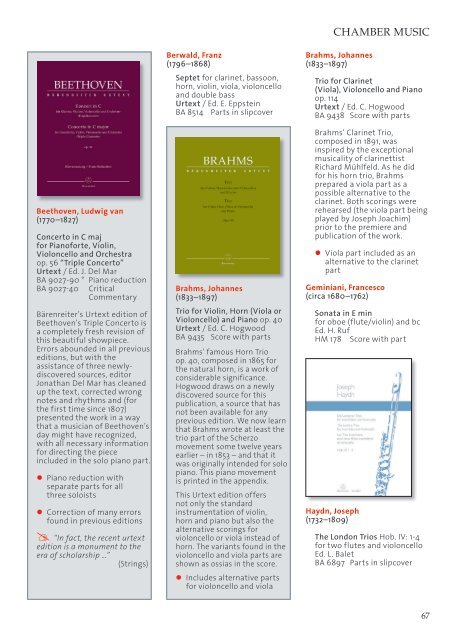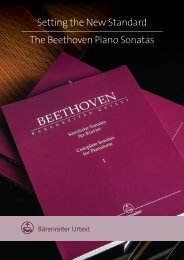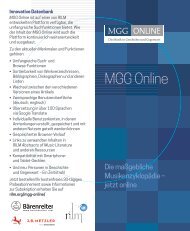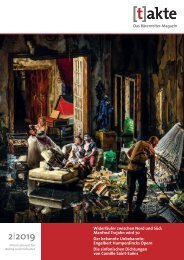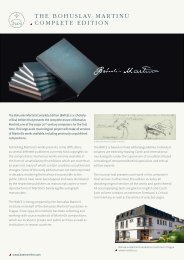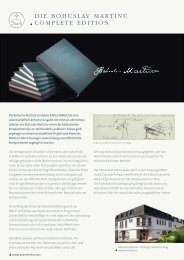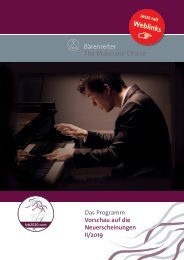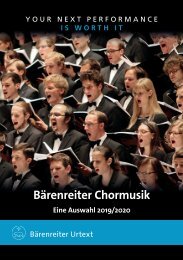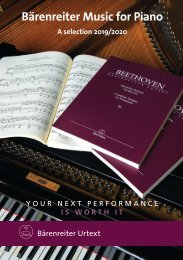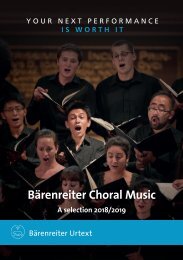SPA234_Strings_2018_2019_web_mit_Links
Create successful ePaper yourself
Turn your PDF publications into a flip-book with our unique Google optimized e-Paper software.
Chamber Music<br />
Beethoven, Ludwig van<br />
(1770–1827)<br />
Concerto in C maj<br />
for Pianoforte, Violin,<br />
Violoncello and Orchestra<br />
op. 56 “Triple Concerto”<br />
Urtext / Ed. J. Del Mar<br />
BA 9027-90 ° Piano reduction<br />
BA 9027-40 Critical<br />
Commentary<br />
Bärenreiter’s Urtext edition of<br />
Beethoven’s Triple Concerto is<br />
a completely fresh revision of<br />
this beautiful showpiece.<br />
Errors abounded in all previous<br />
editions, but with the<br />
assistance of three newlydiscovered<br />
sources, editor<br />
Jonathan Del Mar has cleaned<br />
up the text, corrected wrong<br />
notes and rhythms and (for<br />
the first time since 1807)<br />
presented the work in a way<br />
that a musician of Beethoven’s<br />
day might have recognized,<br />
with all necessary information<br />
for directing the piece<br />
included in the solo piano part.<br />
Piano reduction with<br />
separate parts for all<br />
three soloists<br />
Correction of many errors<br />
found in previous editions<br />
“In fact, the recent urtext<br />
edition is a monument to the<br />
era of scholarship …”<br />
(<strong>Strings</strong>)<br />
Berwald, Franz<br />
(1796–1868)<br />
Septet for clarinet, bassoon,<br />
horn, violin, viola, violoncello<br />
and double bass<br />
Urtext / Ed. E. Eppstein<br />
BA 8514 Parts in slipcover<br />
Brahms, Johannes<br />
(1833–1897)<br />
Trio for Violin, Horn (Viola or<br />
Violoncello) and Piano op. 40<br />
Urtext / Ed. C. Hogwood<br />
BA 9435 Score with parts<br />
Brahms’ famous Horn Trio<br />
op. 40, composed in 1865 for<br />
the natural horn, is a work of<br />
considerable significance.<br />
Hogwood draws on a newly<br />
discovered source for this<br />
publication, a source that has<br />
not been available for any<br />
previous edition. We now learn<br />
that Brahms wrote at least the<br />
trio part of the Scherzo<br />
movement some twelve years<br />
earlier – in 1853 – and that it<br />
was originally intended for solo<br />
piano. This piano movement<br />
is printed in the appendix.<br />
This Urtext edition offers<br />
not only the standard<br />
instrumentation of violin,<br />
horn and piano but also the<br />
alternative scorings for<br />
violoncello or viola instead of<br />
horn. The variants found in the<br />
violoncello and viola parts are<br />
shown as ossias in the score.<br />
Includes alternative parts<br />
for violoncello and viola<br />
Brahms, Johannes<br />
(1833–1897)<br />
Trio for Clarinet<br />
(Viola), Violoncello and Piano<br />
op. 114<br />
Urtext / Ed. C. Hogwood<br />
BA 9438 Score with parts<br />
Brahms’ Clarinet Trio,<br />
composed in 1891, was<br />
inspired by the exceptional<br />
musicality of clarinettist<br />
Richard Mühlfeld. As he did<br />
for his horn trio, Brahms<br />
prepared a viola part as a<br />
possible alternative to the<br />
clarinet. Both scorings were<br />
rehearsed (the viola part being<br />
played by Joseph Joachim)<br />
prior to the premiere and<br />
publication of the work.<br />
Viola part included as an<br />
alternative to the clarinet<br />
part<br />
Geminiani, Francesco<br />
(circa 1680–1762)<br />
Sonata in E min<br />
for oboe (flute/violin) and bc<br />
Ed. H. Ruf<br />
HM 178 Score with part<br />
Haydn, Joseph<br />
(1732–1809)<br />
The London Trios Hob. IV: 1-4<br />
for two flutes and violoncello<br />
Ed. L. Balet<br />
BA 6897 Parts in slipcover<br />
67


